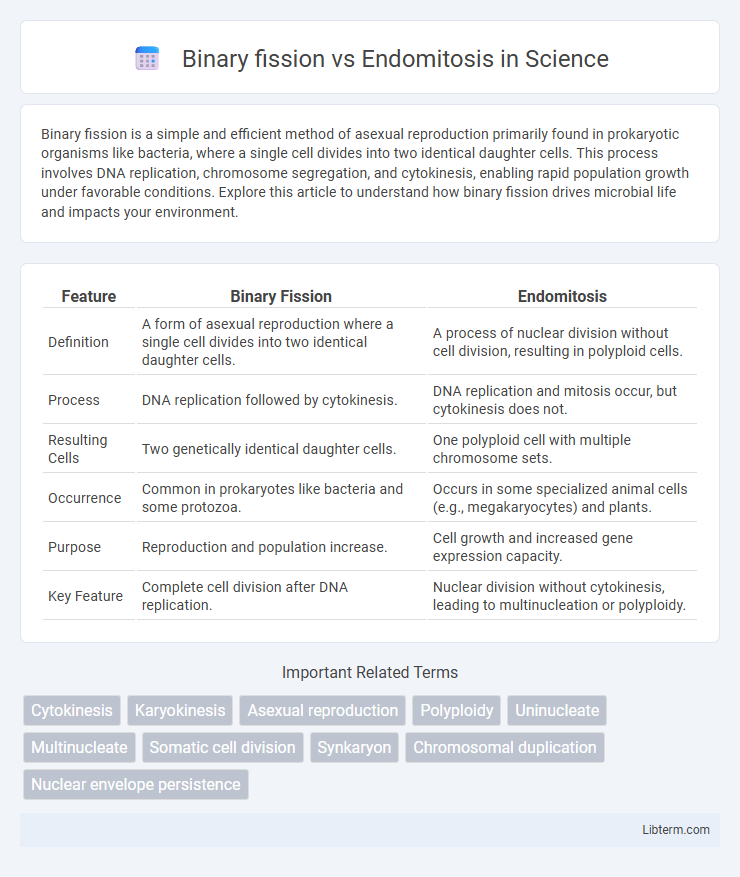Binary fission is a simple and efficient method of asexual reproduction primarily found in prokaryotic organisms like bacteria, where a single cell divides into two identical daughter cells. This process involves DNA replication, chromosome segregation, and cytokinesis, enabling rapid population growth under favorable conditions. Explore this article to understand how binary fission drives microbial life and impacts your environment.
Table of Comparison
| Feature | Binary Fission | Endomitosis |
|---|---|---|
| Definition | A form of asexual reproduction where a single cell divides into two identical daughter cells. | A process of nuclear division without cell division, resulting in polyploid cells. |
| Process | DNA replication followed by cytokinesis. | DNA replication and mitosis occur, but cytokinesis does not. |
| Resulting Cells | Two genetically identical daughter cells. | One polyploid cell with multiple chromosome sets. |
| Occurrence | Common in prokaryotes like bacteria and some protozoa. | Occurs in some specialized animal cells (e.g., megakaryocytes) and plants. |
| Purpose | Reproduction and population increase. | Cell growth and increased gene expression capacity. |
| Key Feature | Complete cell division after DNA replication. | Nuclear division without cytokinesis, leading to multinucleation or polyploidy. |
Introduction to Binary Fission and Endomitosis
Binary fission is a prokaryotic asexual reproduction process where a single cell divides into two genetically identical daughter cells by replicating its DNA and splitting the cytoplasm. Endomitosis is a specialized cell cycle variation in eukaryotic cells characterized by DNA replication without subsequent mitosis or cytokinesis, resulting in polyploid cells with multiple chromosome sets. Understanding these mechanisms highlights fundamental differences in cellular replication strategies across organisms.
Definition of Binary Fission
Binary fission is an asexual reproduction process in prokaryotic organisms, where a single cell divides into two genetically identical daughter cells by replicating its DNA and splitting its cytoplasm. Unlike endomitosis, which involves DNA replication without cell division resulting in polyploid cells, binary fission ensures equal partitioning of genetic material into two separate cells. This mechanism is fundamental in bacterial propagation and differs significantly from eukaryotic cell cycle processes.
Definition of Endomitosis
Endomitosis is a specialized cell cycle process in which the cell replicates its DNA without undergoing cytokinesis, resulting in polyploid cells with multiple copies of chromosomes contained within a single nucleus. Unlike binary fission, which is a form of asexual reproduction involving complete division into two daughter cells, endomitosis leads to increased nuclear content without cell division, commonly observed in certain animal tissues such as megakaryocytes. This distinction highlights endomitosis as a mechanism for cellular growth and differentiation rather than reproduction.
Cellular Mechanisms Involved
Binary fission involves the replication of a single circular chromosome followed by the division of the cytoplasm, allowing prokaryotic cells such as bacteria to reproduce rapidly. Endomitosis, observed in some eukaryotic cells like megakaryocytes, entails DNA replication without subsequent cell division, resulting in polyploidy through repeated rounds of DNA synthesis without mitosis. Key cellular mechanisms include the regulation of DNA polymerase activity in binary fission and the controlled bypass of mitotic spindle formation during endomitosis.
Key Differences Between Binary Fission and Endomitosis
Binary fission is a prokaryotic asexual reproduction process involving the division of a single cell into two identical daughter cells, with DNA replication followed by cytokinesis. Endomitosis occurs in eukaryotic cells where the nucleus undergoes DNA replication and mitosis without cytokinesis, resulting in polyploid cells with multiple chromosome sets. The key difference lies in binary fission producing two separate cells, while endomitosis leads to a single cell with increased chromosome number and no cell division.
Biological Significance in Different Organisms
Binary fission is a key reproductive process in prokaryotes, such as bacteria and archaea, enabling rapid population growth and genetic consistency by producing genetically identical daughter cells. Endomitosis occurs mainly in certain eukaryotic cells like megakaryocytes in humans, facilitating polyploidy, which enhances cell size and metabolic capacity without cell division. Both processes are vital for organismal adaptation: binary fission supports survival through swift replication in unicellular organisms, while endomitosis aids in specialized functions and development of complex tissues in multicellular organisms.
Examples of Binary Fission in Nature
Binary fission is a common asexual reproduction method found in prokaryotes such as bacteria and archaea, with Escherichia coli and Staphylococcus aureus being prime examples. In contrast, endomitosis occurs in certain eukaryotic cells, like megakaryocytes in bone marrow, where the cell undergoes DNA replication without division, leading to polyploidy. Binary fission enables rapid population growth in microorganisms by evenly splitting genetic material, while endomitosis supports specialized cell functions requiring increased DNA content.
Examples of Endomitosis in Nature
Endomitosis occurs in specific cell types like megakaryocytes in bone marrow, which produce platelets by replicating DNA without cell division. Polyploid cells in liver tissue and certain insect species also exhibit endomitosis, allowing increased cell size and metabolic capacity. This process contrasts with binary fission, a common prokaryotic reproduction method involving complete cell division.
Advantages and Disadvantages of Each Process
Binary fission offers rapid and efficient reproduction, enabling quick population growth with minimal energy investment, but it results in genetically identical offspring, limiting genetic diversity. Endomitosis allows cells to increase their DNA content without cell division, enhancing cell size and metabolic capacity, which is advantageous for specialized functions, though it can lead to polyploidy-associated issues such as genomic instability. Each process serves specific biological roles, with binary fission favoring reproduction in prokaryotes and endomitosis supporting complex eukaryotic cell differentiation.
Conclusion: Comparisons and Implications
Binary fission produces two genetically identical daughter cells through simple cytoplasmic division, primarily in prokaryotes, while endomitosis involves genome duplication without cell division, resulting in polyploid cells common in specific eukaryotic tissues. The contrasting cellular outcomes highlight binary fission's role in rapid population expansion and endomitosis's function in generating specialized, multinucleated cells with enhanced metabolic capacity. Understanding these mechanisms elucidates their evolutionary implications and informs biomedical research on cell cycle regulation and tissue development.
Binary fission Infographic

 libterm.com
libterm.com